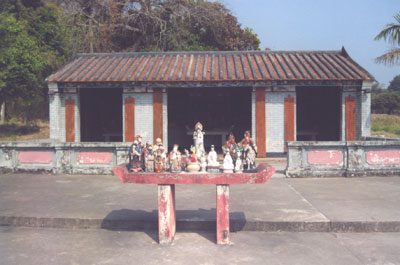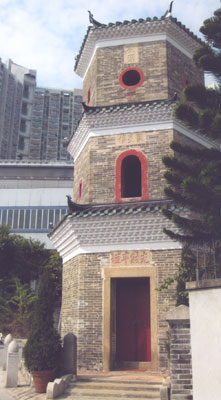Ping Shan Heritage Trail, Hong Kong
This item appears on page 62 of the March 2012 issue.
Hong Kong is full of wonderful “secret” corners to explore. Of course, there are the “must sees” — Victoria Peak, the Star Ferry, Aberdeen, Stanley and the Temple Street Night Market, among many others — that most visitors with four or five days wouldn’t want to miss. But for those with more time in this exciting, frenetic city, there are special places that remain uncrowded and unhurried and are perfect for anyone interested in the past and wanting a glimpse into life in present-day Hong Kong. Some of these special places — many dating back centuries — are linked together into the Ping Shan Heritage Trail. Members of the Chinese Tang clan were among the earliest settlers in the New Territories, which lie north of Hong Kong, between Hong Kong and the Chinese border.
They arrived sometime in the 10th to 11th centuries, establishing small villages, some of which were walled for protection against roving bandits. One of them, Tang Yuen-ching, settled in the area called Ping Shan about 800 years ago. It is this area that my husband, Paul, and I visited on a self-guided tour in February 2011.
Beginning of trail
The first sight on the Ping Shan Trail was the Tsui Sing Lau Pagoda. This hexagonal, three-story green-brick structure is unique. Dating from the 15th century, it is the oldest pagoda in the New Territories and one of the few left in either the New Territories or Hong Kong. Nearby is a structure most people would pass right by. It’s an unpretentious-looking brick altar that is important in traditional Chinese villages. This one is dedicated to She Kung, an earth God who protects villagers. Stones are placed on the altar to show that the god is present. This altar was apparently well visited, judging from the pile of small stones lying atop it. We added our own pebbles to the pile. Next to the altar is an incinerator in which fake paper money is burned as an offering to ancestors. On this trip, we bought and carried some “hell money,” as it’s called, to burn in the incinerators found in most temples and shrines. We feel it adds a richness to the trip to participate in some of the rituals when one can. Hell money can be purchased in stores specializing in paper goods to be burned in honor of one’s ancestors. These goods include not only fake million-dollar bills but also miniature computers, cars, houses, clothing and even food on plates, all made of paper. You can even buy paper servants.
Walled village
Sheung Cheung Wai is the only walled village along the Ping Shan Trail. Dating from the early 19th century, it is a neat, symmetrical compound of old houses, still lived in, enclosed within a massive green-brick wall that is entered through a gatehouse that looks like a small fortress (which is exactly what it must have been in times of trouble). The “main street” of the tiny village leads directly to the small, well-tended ancestral shrine. Very close to this walled village is another village, Hang Tau Tsuen, this one without a wall. Between the two lies an ancient well that was once used by both villages. A short path from the well leads to the Yeung Hau Temple, dedicated to the deity Hau Wong, who may have been a Song Dynasty general. On a stone altar in front of the three rooms that comprise the simple temple was a large assortment of statues placed there as offerings to the three gods within the temple: Hau Wong, To Tei (an earth god) and Kam Fa (god of expectant mothers). We again burned some hell money in the incinerator beside the altar.
Ancestral halls
Next on the trail are two magnificent ancestral halls, standing shoulder to shoulder and almost identical, although one is much older than the other.
The Tang Ancestral Hall, constructed in 1273, consists of three halls and two internal courtyards. It served as the main ancestral hall of the Tang clan in this area. It is worth noting the wooden beams and brackets as well as the dragons adorning the rooftops. The adjacent Yu Kiu Ancestral Hall, similar in layout to the Tang Hall, was built 250 years later. It, too, has three halls and two courtyards. Painted “guardians” on the front wooden doors prevent evil spirits from entering the hall. Next to the late-19th-century Kun Ting Study Hall, where Tang clan students studied for the imperial civil service examinations, is the Ching Shu Hin, a guest house built at about the same time and used for visitors and scholars. It’s linked to the Study Hall by a tiny, overhead footbridge. The guest house is richly decorated with carved panels and brackets and gives a good idea of a wealthy Chinese family’s private residence.
Fishermen’s temple
We ended our walk at the Hung Shing Temple, where yet another god of fishermen is worshiped. Built in 1767, this temple is a two-hall building with a small courtyard. Renovations were in progress when we visited, but the repairmen ushered us in so we could pay our respects to the resident god. The Ping Shan Trail is one kilometer long and took us a leisurely 2½ hours to complete with stops at all the sights mentioned. There is a row of simple restaurants at the end of the trail for those, like us, needing a cup of tea and some noodles after the stroll. The trail is easily reached by MTR subway, getting off at the Tin Shui Wai station. The Tsui Sing Lau Pagoda at the beginning of the trail is across the street from the station. It’s about a 45-minute trip on the MTR from the Star Ferry in Tsim Sha Tsui in Kowloon to the Tin Shui Wai station. There are two excellent booklets covering the Ping Shan Heritage Trail: “Ping Shan Heritage Trail,” published by the Hong Kong Antiquities & Monuments Office, and “Hong Kong Walks,” which includes the trail, published by the Hong Kong Tourism Board. Both booklets are available free from Hong Kong Tourism Board offices, found on Hong Kong Island, in Kowloon and at the international airport.
Two more to see
There are two additional sites that visitors with time and interest should consider visiting. • One is the Lei Cheng Uk Han Tomb Museum, at 41 Tonkin Street in Sham Shui Po in Kowloon. It is the site of a tomb dating from the Han Dynasty (200 BC-AD 200). No one knows for sure who was buried in this tomb — or even if anyone was buried there because no bones have been found — but the assortment of pottery and bronze objects found in the tomb indicate that it must have been built for a high-ranking Han official. There’s a beautiful, quiet garden next door to the museum. The museum is open 10-6 Monday to Wednesday plus Friday and Saturday and 1-6 Sunday. There’s no admission charge. • There’s also the Sam Tung Uk Museum, at 2 Kwu Uk Lane in Tsuen Wan. This walled village, founded in 1786, is one of the oldest in Hong Kong. Once occupied by the Hakka Chan clan, its small, neat houses now contain displays. Open 9-5 every day. No admission charge.


